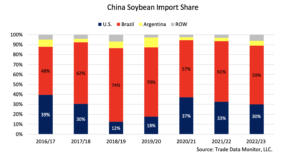Bloomberg's Clarice Couto reported this past Friday that "a surprising tax change in agriculture powerhouse Brazil has the potential to make soy grown in the world’s largest bean exporter less…
FAS: “2022/23 China Soybean Imports Raised to Record High”
In its monthly Oilseeds: World Markets and Trade report on Friday, the USDA’s Foreign Agricultural Service (FAS) indicated that, “This month, USDA raised 2022/23 (Oct-Sep) China soybean imports to a new record of 100.0 million tons. Imports are expected to remain high in the last quarter of the year as the world’s top buyer sources competitively-priced soybeans from South America as well as clears the customs backlog of cargoes that have already arrived.
“Through 10 months of the current marketing year, China has already imported nearly 84.5 million tons of soybeans, with almost 30.0 million sourced from the United States. Total arrivals to date are 10 percent higher compared to the same period last year, with the United States capturing about 40 percent of that growth.”

The FAS update added that, “Shipments from the United States trailed off in April as Chinese buyers took advantage of a bumper Brazilian soybean crop and attractive prices.
Top 10 U.S. export🚢 markets for #soybeans, by volume, https://t.co/uLkBR0QRB2
— FarmPolicy (@FarmPolicy) August 11, 2023
* #China🇨🇳 pic.twitter.com/CmgZ0Khopk
“Smaller suppliers of soybeans to China have also increased their exports. The ‘soy dollar’ program in Argentina contributed to recovery in shipments in the first half of 2022/23. Canada and Russia also increased exports to China this year on higher soybean production and relatively flat crush.

“In 2023/24, China is projected to remain the world’s largest soybean buyer with imports forecast at 99.0 million tons. China is likely to continue buying larger volumes of soybeans from Brazil and potentially less from the United States. Prices of the new U.S. crop have been rising on lower supply expectations, while Brazil output prospects remain robust.”
Meanwhile, Bloomberg writer Hallie Gu reported on Friday that,
China’s farmers are facing an earlier than expected assault on their crops this year as extreme weather accelerates the spread and growth of destructive diseases and pests such as the dreaded fall armyworm.
“At risk are key crops including corn and rice, a globally important food staple that’s already seeing threats to supply elsewhere in Asia. China is the world’s biggest producer and importer of the grain that feeds billions.”
Top 10 U.S. export markets for #corn, by volume, https://t.co/uLkBR0QRB2
— FarmPolicy (@FarmPolicy) August 11, 2023
* #China🇨🇳
* #Colombia 🇨🇴
* #Canada🇨🇦 pic.twitter.com/CbX5EwSsDe
The Bloomberg article added that, “Plant pests that ravage crops are becoming more destructive and posing a bigger threat to the world’s food security due to climate change, according to the Food and Agriculture Organization, a UN agency. China’s government said heavy rains and winds, including those whipped up recently by deadly Typhoon Doksuri, have helped with the migration of insects and spread of disease.”







